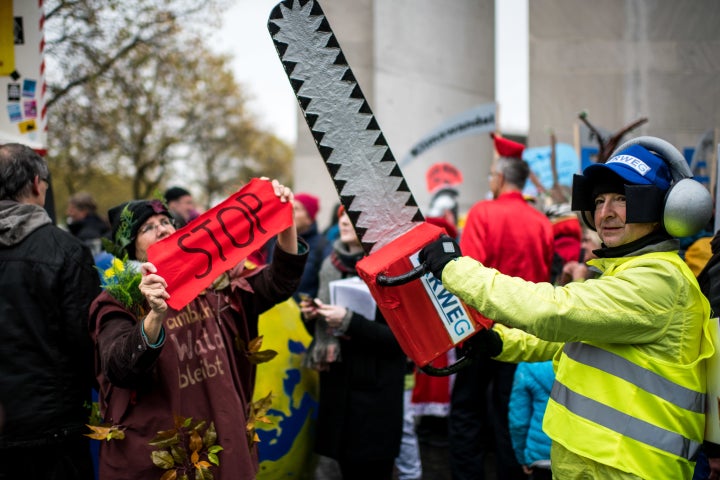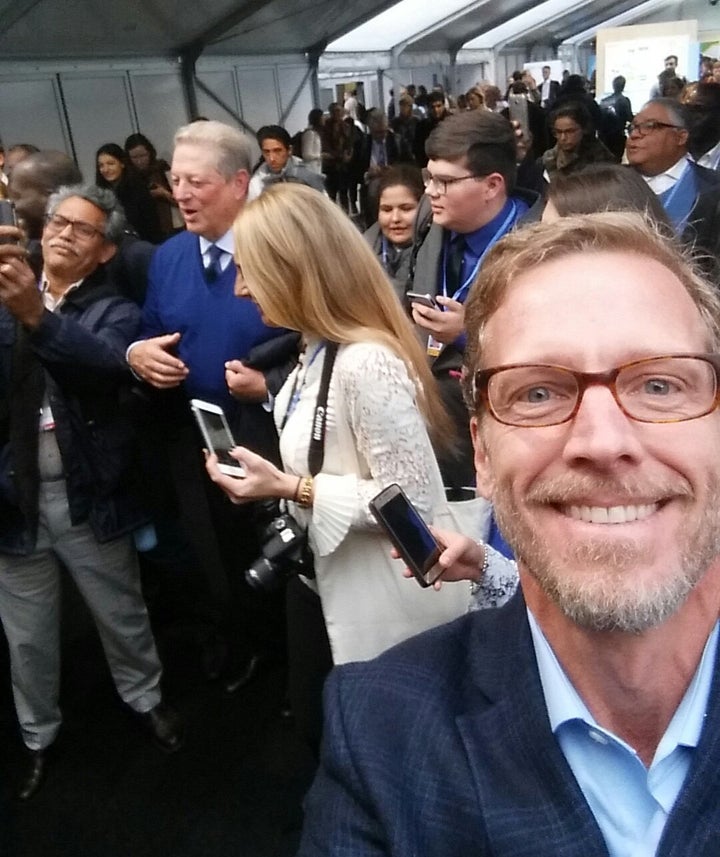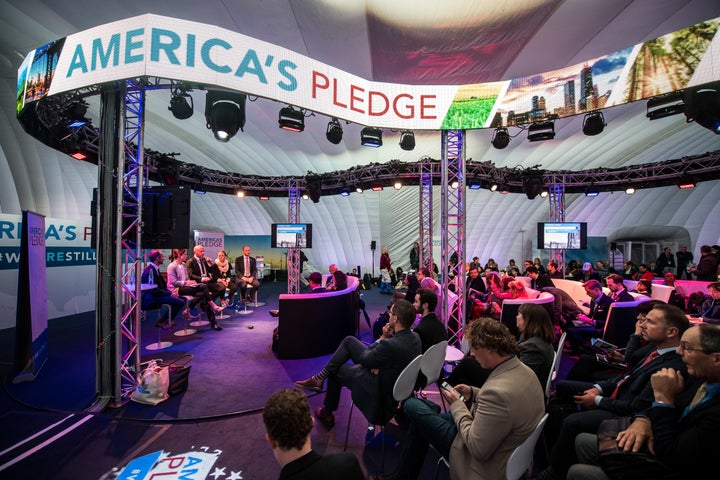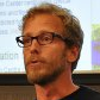
For climate policy geeks like me, it’s the Coachella of climate change. The UN Framework Convention on Climate Change (UNFCCC) stages a meeting each year, known as the Council of the Parties, or COP, to negotiate international mechanisms for addressing the causes and impacts of climate change. This year it was led by Fiji and located at the UNFCCC headquarters in Bonn, Germany.
I attended the 21st such meeting, COP21, in Paris, France as a U.S. federal employee and had the opportunity to witness history as the Paris Agreement was deliberated and eventually signed. Times have changed, however. As the Trump administration’s first and only climate whistleblower (so far), I had a fat chance of getting invited to join the U.S. delegation this year, but with the kind cooperation and support of Sweden and the Stockholm Environment Institute, I was able to make it to Bonn, Germany in time for the main events at COP23.
Upon arrival I collected my credentials and explored the Pavilion area where countries from around the world had set up exhibition spaces for presentations and discussions. It’s difficult to describe the strangely artificial but cosmopolitan experience of wandering among these delegation pavilions, speaking with their representatives, strolling from South Korea to Senegal, meandering from Morocco to Malaysia as if a sterilized version of the planet had just shrunk down to the size of a city park. The sense of wonder lasts about an hour or so before the demands of a busy schedule spread out across a giant venue deaden the experience somewhat.
Due to speak on Arctic resilience at the Nordic Pavilion in 10 minutes, I was chatting with my fellow panelist, Eva Svedling, Sweden’s Deputy Foreign Minister, when she mentioned that former Vice President Al Gore was wrapping up a presentation in a meeting room on the opposite side of the Pavilion area. As an outspoken climate change icon, Mr. Gore is in high demand at these events, but I wanted to try to shake his hand and thank him for his climate advocacy. I hustled past the UK pavilion (whiskey tasting on Sunday!), the green, leafy Brazil pavilion, the French pavilion with its “Paris Agreement Café”, the warm and tropical Fiji host pavilion, and the elaborate lighting of the high tech India pavilion. Seeing a throng up ahead I knew I was in the right place, and soon spotted the VP being swarmed by well-wishers taking selfies and trying to shake his hand.
So mobbed he could barely make his way through the crowd, the VP was patiently thanking everyone over and over. I tried to move in but no luck. For a moment the amoeba-like crowd movement pulled me in toward him, but just as quickly I was on the outside looking in. I decided to take a long-distance selfie and get back to the Nordic Pavilion for my talk.

Just as I was turning to leave, a slender, be-suited young man took me by the arm and asked “Are you Joel Clement?” Puzzled, I said yes and his response stunned me: “He’d love to meet with you, can you come with us now?” For a half second I let it sink in that the vice president wanted to meet with me, and then I nearly said yes, throwing the Swedes under the bus, before coming to my senses. We set up a meeting for later in the day and I made it back to the Nordic pavilion in time for my session. In this dramatic and surprising way I was welcomed to the annual clima-palooza that brings the world’s climate thought-leaders together to fret and geek out on the most important issue of our time; an event where apparently a climate whistleblower has minor celebrity status.
This was one of many interactions that reminded me of just how significant these COP meetings are, and it had nothing to do with the negotiations that were taking place over in the “Bula Zone,” the meeting space at the other end of Rheinaue Park that was reserved for official state delegations. While negotiators were grinding through the excruciating details of implementing the Paris Agreement, representatives from all of civil society were mingling in the “Bonn Zone”, a facility that was funded and built, remarkably, to facilitate international, cross-sector interactions on the threats and opportunities associated with climate change. To put it a different way, once a year there is a huge investment in fostering the international community of practice that is tackling the biggest challenge facing modern civilization. The negotiators get the press, but the world-changers are strolling around the pavilions, sitting in meeting rooms, and sharing ideas big and small that will change lives.
At a time when the world seems focused on the negative effects of an unhinged, ignorant American president who questions the causes of climate change, it was invigorating to see so much energy dedicated to climate solutions.
And, contrary to expectations, the Americans did not disappoint. With President Trump pledging to pull the U.S. out of the Paris Agreement at the earliest opportunity, and with oil, gas, and coal interests running the executive branch of the U.S. government, expectations for the United States were beyond low. Sure enough, the official U.S. delegation remained cloistered in a closed-door meeting room and, for the first time, the U.S. didn’t even bother to host a pavilion. By ceding this role, however, the federal delegation created a huge opportunity for the rest of American civil society to step in. With generous funding from Michael Bloomberg and others, a massive “Climate Action Center” was inflated in the open area between the Bula Zone and the Bonn Zone pavilion space. I say inflated because it actually was an inflated structure that looked like a moon-bounce with multiple domes. At 2500 square meters, it was the largest pavilion at COP23.

In this pavilion, leaders of 20 U.S. states, over 100 cities, and over 1,400 corporations pledged their allegiance to the Paris Agreement with the hashtag slogan #wearestillin, and described their own commitments to limiting greenhouse gas emissions. The parties to America’s Pledge, as their collective action was called, represented a combined economy larger than every nation on earth other than China and the United States. While questions remain about tracking and verifying these pledges, the American display of ambition more than compensated for the disgraceful rhetoric coming from the White House. America’s Pledge was warmly received by other national delegations and praised by heads of state such as France’s Emmanuel Macron and Germany’s Angela Merkel as they arrived in Bonn for the second week of deliberations. Standing on the sidelines, I indulged in a little American pride that this collective action would likely be the top headline from COP23.
While the Bonn Zone and the Climate Action Center were highlighting these positive efforts to limit greenhouse gases, build resilience, and cooperate to help less affluent nations achieve their own goals, the Bula Zone was a more stressful environment. At this COP, negotiators were tasked with establishing the scope and details of the “rule book” that would assure transparent and fair implementation of the national pledges associated with the Paris Agreement. With the expectation that this rule book would be adopted at next year’s COP in Poland, there was considerable pressure to make significant headway, and by all accounts it was a slow, fraught, and not entirely successful process.
As one might expect when creating rules of compliance, old tensions between developed and developing countries re-emerged. In particular, developing countries worried about being able to measure and report mitigation progress at the scale and detail that developed countries hoped to establish, and developed countries worried about consistent reporting protocols from all parties. The liability issues of “Loss and Damage” continued to vex the parties, who put off major decisions until next year, as did the finance details of relocating the Adaptation Fund – formerly linked to carbon markets under the Kyoto Protocol – to serve a Paris Agreement framework that has not yet established a shared position on such market mechanisms.
And then there were the personalities. As usual, certain vocal delegations dominated the proceedings and the facilitators had to resort to accepting minimal, incremental progress – the lowest common denominator in many cases – to keep things moving along. This is part and parcel to international negotiations but it’s regrettable that the increased ambition and leadership that had been growing since COP21 in Paris was not as universal as it appeared over in the Bonn Zone.
Not that the negotiations were a failure, there were several notable achievements. The Adaptation Fund was approved as a finance mechanism to serve the Paris Agreement and received some much-needed financial commitments; an “Ocean Pathway Partnership,” co-chaired by Sweden and Fiji, was launched to explore the interactions of climate change and the world’s oceans; a Gender Action Plan was approved with the intention of increasing the participation of women in UNFCCC deliberations; and a Local Communities and Indigenous People’s Platform was finalized as a means to give greater voice to indigenous people in the climate negotiations.
Unfortunately the American “can-do” spirit on display in the Climate Action Center was lacking in the Bula Zone. While the Americans were less vocal than in previous years, President Trump’s intention to renegotiate the Agreement to be more favorable for Americans hung like a pall over the proceedings, as did uncertainties about US funding for the Green Climate Fund, an essential component of the UNFCCC that was established to provide developing countries with the necessary capacity to adapt.
But those struggles almost seemed beside the point at this COP. Despite the typical lack of ambition in the Bula Zone, the commitment and ambition on display in the Bonn Zone and the Climate Action Center set the tone for COP23. Hundreds of climate solution projects and initiatives around the world were featured, and, rather than provide the international buzz-kill that was expected, Americans amplified the energy with America’s Pledge and other initiatives. Leaders like Al Gore, Michael Bloomberg, Governors Jerry Brown (CA) and Jay Inslee (WA), mayors from around the U.S., and the corporate titans they brought along showed that there is an abundance of ambition at the scale where change actually takes place. The Bonn-Fiji Commitment, announced toward the end of COP23, amplified this headline by taking the focus on local and regional-scale efforts to the international level.
The negotiators still have to keep the work going in the bureaucratic trenches, but they will soon find themselves leading from behind as the rest of civil society advances forward. Maybe this is how it should be; there is no question that we need to accelerate climate action well beyond the speed limit of international negotiations. All I know is that my goosebumps in Bonn didn’t just come from an invigorating chat with Vice President Gore, they came from witnessing all that he and his fellow leaders from around the world brought to a momentous gathering by the banks of the Rhine River in 2017.
#wearestillin
